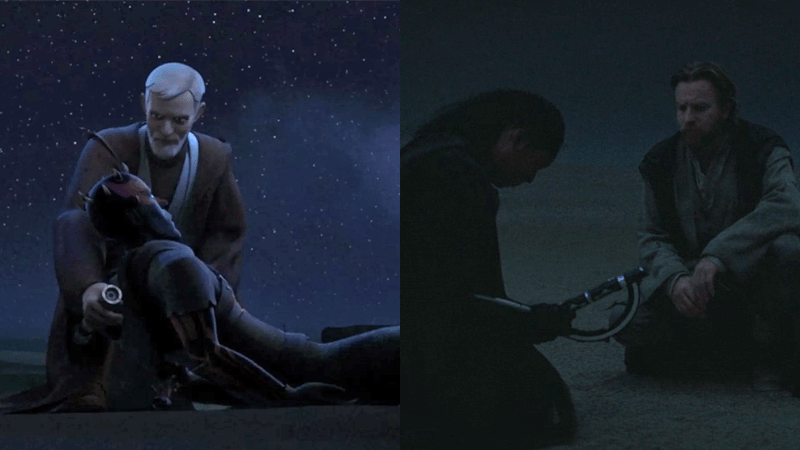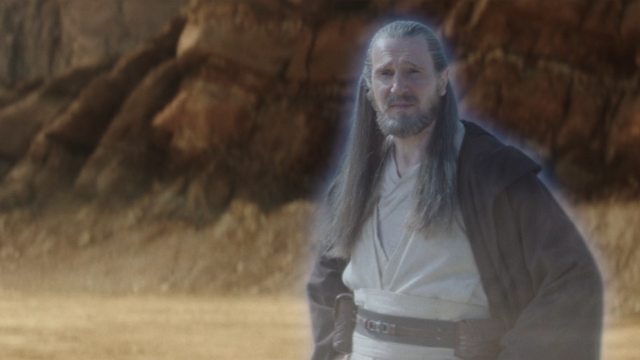There’s been a bit of a strange recurrence in Star Wars recently: more often than not, people just don’t die. The Rise of Skywalker, infamously perhaps, is predicated on the return of the Emperor with little explanation as to how he got out of a one-way trip down an exploding reactor shaft. Obi-Wan Kenobi just gave us not one, but two people surviving mortal lightsaber wounds through sheer determination.
So yeah, people are having a bit of a hard time not sticking around in the galaxy far, far away at the minute. But it’s also not exactly a new thing, really: Darth Maul infamously survived becoming Half Maul when he returned in The Clone Wars with some sick robo-spider legs. Anakin, of course, managed to endure the loss of several limbs and being burned alive long enough to be evacuated by Palpatine after fighting Obi-Wan on Mustafar. It’s all kind of silly, and in a certain way, for a series that is so fascinated and burdened by its own past, there’s a dark humour in the commentary that Star Wars just can’t let some things die. Unless they’re random mooks or, sadly, Han Solo, apparently.
But both those characters, and the characters we’ve seen cheat death this way recently — Palpatine in Rise, and both the Grand Inquisitor and Reva in Obi-Wan — all have something in common: they are practitioners of the Dark Side of the Force. The excuse, if any, given for them surviving fatal maimings is the emotion that they draw their power from in the first place: they’re literally just too mad to die, a sheer force of will to endure out of spite and rage that lets them defy impossible odds.

It’s kind of fascinating to see Star Wars lean on this idea more and more, especially because it’s not the only way of cheating death we’re seeing more of lately — the Light Side of this dichotomy is getting in on it too, as we see and hear more from spirits of the Force in these stories as well. This is seen with Liam Neeson’s last-minute manifestation as Qui-Gon Jinn, and the voices of Jedi across generations talking to Rey in Rise’s climax, alongside the spirits of Luke and Leia watching over her. If Star Wars is to be so fascinated with this idea of rendering death somewhat toothless, then it is at least gunning for it at an interesting angle beyond lowered stakes or a necessity to never let things go: death still matters to some people in the galaxy far, far away… from a certain point of view.
Centering this idea around Force users specifically — like we said, we’ve seen people bite the bullet in Star Wars plenty enough lately, they just happen to be regular folks, soldiers and bounty hunters far removed from the spiritual conflict of the Skywalker Saga — creates this fascinating idea of contrast. It’s long been established canon (at least, as far as we continue to be aware, always in motion the Force is, and so on and so forth) that the ability to manifest as a Force Ghost is one open only to practitioners of the Light. It’s why, allegedly, Palpatine spent so much of his life as Emperor desperately seeking out increasingly arcane ways to preserve his soul beyond his original body, after all. But it also suddenly clicks into making sense of why we’re seeing so many Dark Siders beyond him — who lack the resources to just pop off to a far-flung planet and set up a cult of cloners — rail against dying so much that they endure what should be mortal wounds.

But for the Jedi, death is all but a manner of an elevated sense of perspective. Qui-Gon’s journey as a Force ghost in tie-in material as of late has been about his growing mastery of this new form that allows him to transcend traditional perspectives — he can eventually physically interact with the corporeal world, he can see through time itself. Yoda, in The Last Jedi, has also gained some semblance of this idea, broadening his perspective. To the Jedi, death is not the end but the beginning of something new, a persistence beyond one form as you step into, as Obi-Wan told Luke in A New Hope, a larger world. All that it requires is that a Jedi lets go, literally of their physical body but also spiritually of the concept that that body provided all the perspective that they were able to perceive, to gain this vast new level of potential.
If we compare this to the Dark Siders we’ve seen “cheat” death recently then, there’s an intriguing parallel. Without such a similar ability known to them, the Dark Side is embraced by the act of not letting go at all, holding on to every little thing — anger, fear, revenge, the fact that your legs are suddenly not attached to your torso — and such a desire channeling the Force itself to sustain yourself through horrendous injury. Pain as sustenance for the Dark Side is a common idea in Star Wars, in so much that it evokes the passion that grants the Sith and their acoyltes the strength they crave. But reframing it as this idea that, given the alternative is physical and spiritual oblivion, these people are simply just too furious to give up presents a contrast to the Jedi and the Light Side that is far more intriguing than the cyclical tale of good and evil that their conflict is typically framed as. Two different perspectives on the same thing, something Star Wars loves to play with so much.

It’s made further more intriguing by two of the more recent examples of Dark Side users moving against this idea: the death of Darth Maul in Star Wars Rebels, and the survival of Reva in Obi-Wan Kenobi. Both centre on these characters confronting that decision of whether or not to let go of their long-held grudges against their masters. For Maul, he still wants to see Palpatine destroyed for abandoning him, even as he masks that desire with his grandiose hatred of Obi-Wan. For Reva, she seeks vengeance against Vader for his massacre at the Jedi Temple in Order 66. Both, at the hands of Obi-Wan Kenobi, are given the chance to let go of that hatred, and we get to see the alternative paths laid out for them: no longer believing he needs to persist, his mission against Palpatine destined to be picked up by another, Maul simply decides that there is no longer a place for him in the world, and fades away. Reva, meanwhile, is given the rare chance of redemption through simply living, instead of the death so many redemption arcs conclude with in Star Wars, by being convinced to let go of the pain and anger she felt over the loss of her fellow Jedi younglings. One chooses to find another way to exist in this current world beyond their hatred, the other simply lets go of it entirely.
In this Force-driven conflict of Light and Dark, Reva’s act in particular is a radical one, a potential defiance of this cyclical idea of spiritual perspective where the Dark is rooted in a physical world, while the Light transcends into a realm beyond it. If Star Wars is to embrace the somewhat absurd idea that some people just can’t stay dead, physically or otherwise, reframing it around these ideas of self is at least much more interesting than awkwardly handwaving fatal lightsaber wounds. After all, Star Wars itself perhaps put it best: no one’s ever really gone. So why not play with that more often?
Want more Gizmodo news? Check out when to expect the latest Marvel and Star Wars releases, what’s next for the DC Universe on film and TV, and everything you need to know about House of the Dragon and Lord of the Rings: The Rings of Power.
